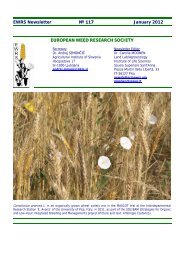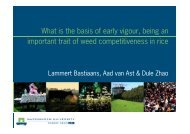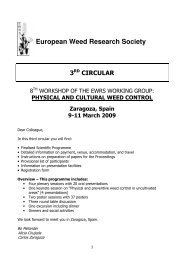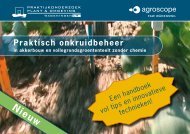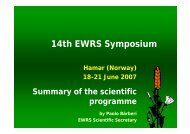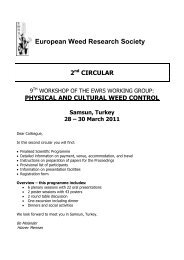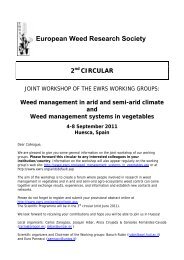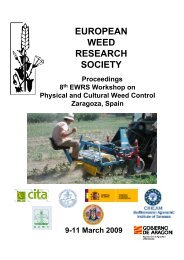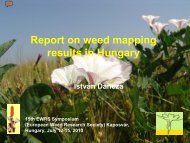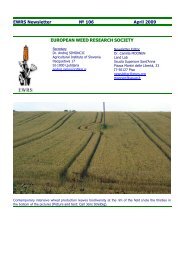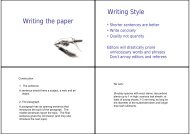Physical and Cultural Weed Control Working Group of - European ...
Physical and Cultural Weed Control Working Group of - European ...
Physical and Cultural Weed Control Working Group of - European ...
You also want an ePaper? Increase the reach of your titles
YUMPU automatically turns print PDFs into web optimized ePapers that Google loves.
9 th EWRS Workshop on <strong>Physical</strong> <strong>and</strong> <strong>Cultural</strong> <strong>Weed</strong> <strong>Control</strong> 67<br />
Samsun, Turkey, 28 – 30 March 2011<br />
(Knezevic <strong>and</strong> Ulloa 2007; Ulloa et al. 2010a, 2010b, 2010c, 2010d; Wszelaki et al. 2007), as it<br />
eliminates concerns over direct residual effects on soil, water, <strong>and</strong> food quality (Ascard 1998) <strong>and</strong><br />
could lessen the reliance on herbicides, h<strong>and</strong> weeding, <strong>and</strong>/or mechanical cultivation (Wszelaki et<br />
al. 2007).<br />
Flame weeding is an acceptable weed control option in organic production <strong>and</strong> has received<br />
considerable attention recently for its potential in both organic <strong>and</strong> conventional production systems<br />
(Bond <strong>and</strong> Grundy 2001; Parish 1990). Propane burners can generate combustion temperatures <strong>of</strong><br />
up to 1900 C, which raises the temperature <strong>of</strong> the exposed plant tissues rapidly (Ascard 1998).<br />
Flaming kills weeds mainly by boiling the water inside the cell, which ruptures cell membranes <strong>and</strong><br />
desiccates tissue (Lague et al. 2001; Rifai et al. 1996). Increase <strong>of</strong> temperatures above 50 C inside<br />
the plant cells results in protein coagulation (Parish 1990; Pelletier et al. 1995), <strong>and</strong> consequently<br />
weeds die, or their competitive ability against the crop is severely reduced. Flame weeding does not<br />
disrupt the soil surface, thus reducing the risk <strong>of</strong> soil erosion, <strong>and</strong> it does not bring buried weed<br />
seeds to the surface, thus minimizing the chance <strong>of</strong> new flushes <strong>of</strong> weeds (Wszelaki et al. 2007).<br />
The susceptibility <strong>of</strong> plants to flaming largely depends on their heat avoidance, heat tolerance, or<br />
both (Ascard 1995).<br />
The efficacy <strong>of</strong> flame weeding was reported to be influenced by several factors, including the<br />
growth stages <strong>of</strong> the plant (Ascard 1994, 1995; Cisneros <strong>and</strong> Z<strong>and</strong>stra 2008; Knezevic <strong>and</strong> Ulloa<br />
2007; Sivesind et al. 2009; Ulloa et al. 2010a, 2010b, 2010c, 2010d), the physical location <strong>of</strong> the<br />
growing point at the time <strong>of</strong> flaming (Ascard 1995; Hansson <strong>and</strong> Ascard 2002; Knezevic <strong>and</strong> Ulloa<br />
2007), the presence <strong>of</strong> protective layers <strong>of</strong> hair or wax <strong>and</strong> lignification (Ascard 1995; Ascard et al.<br />
2007), the technique <strong>of</strong> flaming (Parish 1990), <strong>and</strong> the regrowth potential <strong>of</strong> plant species (Ascard<br />
1995; Ascard et al. 2007). Knezevic <strong>and</strong> Ulloa (2007) conducted some preliminary studies to<br />
examine the response <strong>of</strong> several crops <strong>and</strong> weed species to broadcast flaming <strong>and</strong> observed that<br />
plants were more heat sensitive when flamed in the afternoon than early in the morning. We<br />
hypothesize that such difference are associated with leaf relative water content (RWC), which<br />
varies during daytime. Leaf RWC is the ratio <strong>of</strong> the amount <strong>of</strong> water in the leaf tissue at sampling to<br />
that present when fully turgid. However, there is little published research describing the effect <strong>of</strong><br />
leaf RWC on the response <strong>of</strong> plant species to propane flaming. Leaf RWC depends on many factors,<br />
including air temperature, relative humidity, <strong>and</strong> light intensity, <strong>and</strong> these factors also vary during<br />
the time <strong>of</strong> day (Saini <strong>and</strong> Rathore 1982).<br />
The objectives <strong>of</strong> this research were to determine the time <strong>of</strong> day when selected crop <strong>and</strong> weed<br />
species would be more susceptible to propane flaming <strong>and</strong> determine the relation between flaming<br />
efficacy <strong>and</strong> leaf RWC.<br />
Materials <strong>and</strong> Methods<br />
Plant Materials <strong>and</strong> Growth Conditions. This study was conducted in April <strong>and</strong> repeated in<br />
September <strong>of</strong> 2009 in a greenhouse at the University <strong>of</strong> Nebraska-Lincoln East Campus in Lincoln,<br />
NE. The experiment was set up as a completely r<strong>and</strong>omized design with 16 treatments <strong>and</strong> three<br />
replications. Two crops (corn <strong>and</strong> soybean) <strong>and</strong> two weed species (green foxtail <strong>and</strong> velvetleaf)<br />
were treated with four doses <strong>of</strong> propane (0, 29, 43, <strong>and</strong> 87 kg ha –1 ) at four times <strong>of</strong> day (0, 4, 8, <strong>and</strong><br />
12 h after sunrise-HAS). Seeds were germinated in flats with peat–perlite–loam (1:2:1, v/v/v) soil<br />
mix media. On emergence, one seedling was transplanted into individual 10 cm by 10 cm by 10 cm<br />
pots filled with the same soil mix. Plants were irrigated as needed <strong>and</strong> grown under natural light<br />
supplemented with a 14 h photoperiod with artificial illumination <strong>of</strong> 600 to 1,000 µmol –2 s –1<br />
photosynthetic photon flux density. Plant growth stages at the time <strong>of</strong> flaming were: 4-leaf stage<br />
(V4) for corn, V6 for green foxtail, V2 for soybean, <strong>and</strong> V5 for velvetleaf. The weather data at the<br />
time <strong>of</strong> flaming treatments for the trials are reported in Table 1.



